Worried about safety and high costs in your parking garage? Poor lighting can cause accidents and huge energy bills. COB LED downlights solve both problems with bright, efficient light.
The key benefits are superior brightness, high energy efficiency, and long lifespan. COB downlights create a safer environment by providing focused, uniform light. They also significantly reduce electricity and maintenance costs, making them a smart long-term investment for any parking facility.
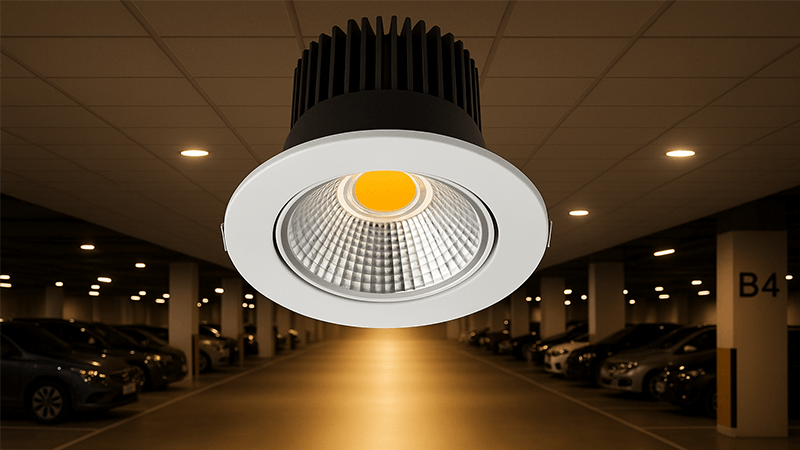
I've spent years in the LED lighting industry, from working on the factory floor to building my own manufacturing business. I've seen firsthand how the right lighting transforms a space. Many of my clients, like Shaz in the UAE, ask about the specifics of parking garage lighting. They want to know why it's so critical and what makes certain technologies better than others. Let's break it down, starting with the basics of why parking lot lighting matters so much.
Why is lighting important in a parking lot?
An unlit parking lot feels dangerous and unprofessional. This can lead to fewer customers and more security incidents. Proper lighting fixes this by ensuring safety and creating a welcoming space.
Lighting is crucial in a parking lot for safety, security, and user experience1. It helps prevent accidents by improving visibility for drivers and pedestrians. It also deters criminal activity and makes people feel safer, which is essential for any commercial or residential building's reputation.
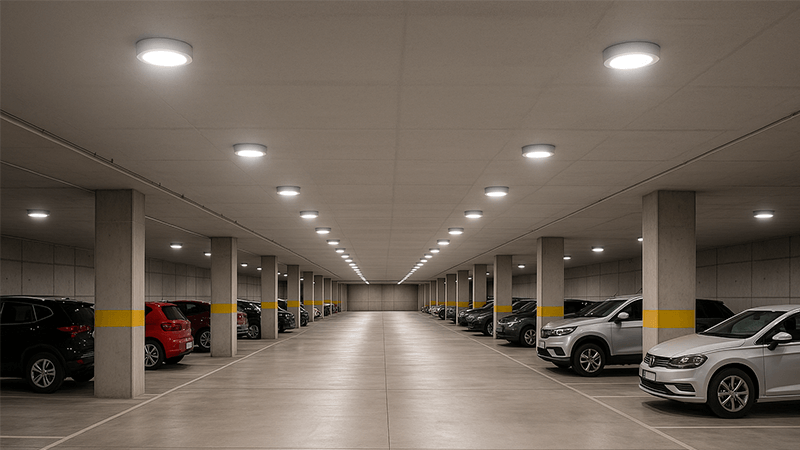
From my experience, upgrading a parking facility's lighting does more than just brighten up the space; it completely changes how people perceive it. The importance goes much deeper than just seeing where you are going. When I talk with purchasing managers, I break down the benefits into three main areas.
Enhancing Safety and Preventing Accidents
Good lighting is the first line of defense against accidents. In a parking garage, drivers need to clearly see parking lines, curbs, speed bumps, and other vehicles. Most importantly, they need to spot pedestrians instantly. Uniform lighting from well-placed fixtures eliminates dark spots and reduces harsh glare. This ensures drivers' eyes don't have to constantly adjust, which reduces eye strain and improves reaction time. I remember a project for a client in Dubai. Their underground garage was dimly lit with old fluorescent tubes. After we installed new LED downlights, they told me their tenants immediately felt safer and even complimented the building management on the upgrade. It's a small change with a big impact.
Boosting Security and Deterring Crime
A dark or shadowy parking garage is an invitation for crime. Bright, consistent lighting is one of the most effective deterrents. It removes hiding spots and makes potential criminals feel exposed. This helps protect both property and people. Good lighting also significantly improves the effectiveness of security cameras. Older, grainy security footage is often useless because of poor lighting. Modern LED lighting provides clear, color-accurate illumination, which allows cameras to capture sharp, detailed images. This makes it easier to identify individuals or read license plates if an incident occurs.
Improving User Experience and Property Value
A well-lit parking garage gives a great first impression. It tells visitors, customers, and tenants that the property owner cares about their safety and comfort. This professional image can directly impact a business's reputation and a building's occupancy rates. For a purchasing manager like Shaz, it's important to understand that good lighting is not an expense, but an asset. It enhances the perceived value of the property and contributes to a positive user experience from the moment someone arrives.
| Feature | Poor Lighting | Good Lighting |
|---|---|---|
| Safety | High risk of accidents, hard to see obstacles. | Low risk of accidents, clear visibility. |
| Security | Invites criminal activity, poor camera footage. | Deters crime, enables clear surveillance. |
| User Feel | Unsafe, unprofessional, causes anxiety. | Safe, welcoming, professional. |
| Property Value | Detracts from the property's image. | Enhances property value2 and reputation. |
How does a COB LED work?
Are you tired of harsh glare from multiple LED sources? This can create uneven light and eye discomfort. COB technology solves this by packing many LEDs into one smooth module.
COB, or "Chip-on-Board," works by mounting multiple LED chips directly onto a substrate to form a single module. This design creates a dense array of LEDs that acts as one large, powerful light source, producing an intense, uniform beam of light without multiple shadows.
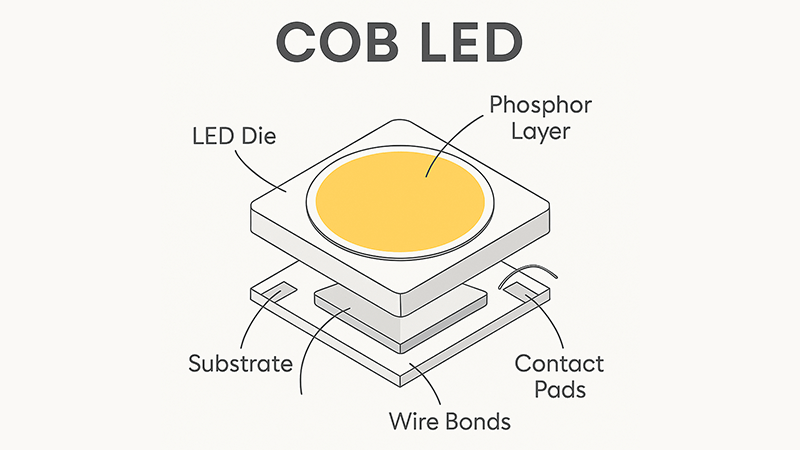
Understanding the technology behind the light is important for making smart purchasing decisions. When I explain COB technology, I focus on its simple but brilliant design and how that design directly impacts performance and reliability. It’s a big step up from older LED technologies.
The "Chip-on-Board" Design
Imagine many tiny light bulbs. Older LEDs, like Surface Mounted Device (SMD) types, are like having all those bulbs spread out. COB, or "Chip-on-Board," is different. It takes the core parts of those bulbs—the tiny LED chips—and places them very close together on a single board, or substrate. This board is often made of aluminum or ceramic, materials that are excellent at conducting heat. The chips are then covered with a layer of phosphor, which is what converts the blue light from the chips into the white light we see. This entire assembly acts as a single, large light source.
Heat Management and Lifespan
This design has a huge advantage: heat management. All those chips packed together generate a lot of heat. But because they are mounted directly onto a heat-conducting substrate, the heat is quickly and efficiently pulled away from the chips. This superior thermal management3 is the key to a long lifespan4. From my experience manufacturing these, thermal management is everything. A poorly designed COB will overheat, and its light output will drop quickly. This is called light decay or lumen depreciation. That is why we insist on a lumen maintenance5 of at least 95% after 2,000 hours of testing. Anything less means the quality is not there, and the light will fail prematurely. You should always ask for this data from a supplier.
Advantages of a Single Module
Compared to older SMD LEDs, the COB design creates a much more uniform light. You don't get the multiple shadows or "hot spots" that can come from an array of individual LEDs. Instead, you get a clean, single beam of light that looks better and is less harsh on the eyes. COB technology also allows for a much higher light density6, meaning more light can be produced from a smaller area. This allows us to create powerful fixtures in very compact designs, which is a big plus for modern architecture7.
| Feature | COB (Chip-on-Board) | SMD (Surface Mounted Device) |
|---|---|---|
| Structure | Multiple bare chips on one substrate. | Individual packaged LEDs on a circuit board. |
| Light Output | Single, uniform beam of light. | Multiple points of light, can cause glare. |
| Heat Dissipation | Excellent, direct path to heat sink. | Less efficient, heat travels through more layers. |
| Light Density | Very High (more light in a smaller area). | Lower. |
| Application | Spotlights, downlights, high-power needs. | Strip lights, bulbs, general area lighting. |
Is COB light better than panel light?
Confused about choosing between COB and panel lights for your space? The wrong light can result in poor performance. Knowing their best uses helps you make the right choice easily.
Neither is "better" overall; they are designed for different purposes. COB lights are better for focused, high-intensity spotlighting8, like in high-ceiling parking garages. Panel lights are better for broad, diffuse lighting9 over a large area, like in an office or retail space with lower ceilings.
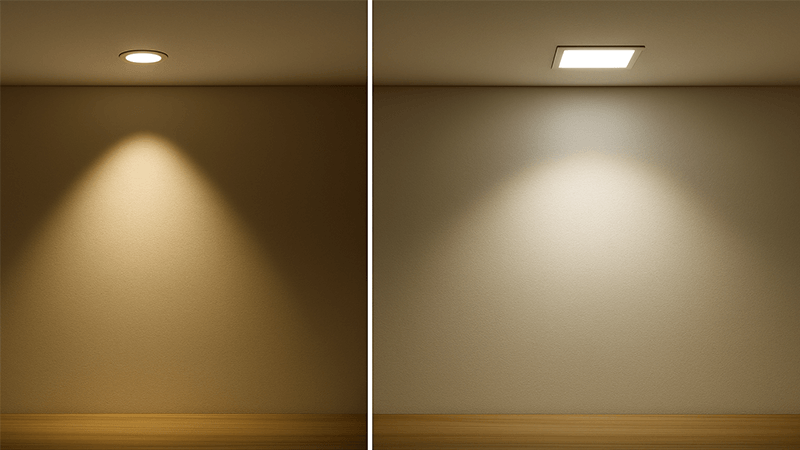
This is one of the most common questions I get from clients. It’s easy to get confused because both are great LED technologies. The key is to match the technology to the application. I always tell my clients to think about where the light needs to go.
Light Quality and Direction
The biggest difference between COB lights and panel lights is how they distribute light.
- COB Light: Think of a COB light as a spotlight. It uses a reflector or lens to create a controlled, focused beam of light. This is perfect for accent lighting, highlighting features, or pushing light a long distance from a high ceiling. It provides high-intensity light in a specific area.
- Panel Light: Think of a panel light as a skylight. It is designed to create a wide, soft, and diffuse blanket of light. It spreads light over a very large area with very low glare, making it ideal for general ambient lighting in spaces with lower ceilings like offices, schools, and hospitals.
Application in Parking Garages
For a parking garage, a COB downlight is almost always the superior choice. Most garages have high ceilings and long driveways. You need a light source with enough "punch" to project bright light all the way down to the floor. The focused beam of a COB downlight does this perfectly, ensuring that driving lanes and parking spaces are brightly and uniformly illuminated. A panel light, in contrast, would spread its light out too much. By the time the light reached the floor from a high ceiling, it would be too dim to be effective or safe. A purchasing manager I work with, Shaz, was once considering flat panels for a multi-level car park. I explained that while panels are great for his office space, the garage needed the punch of COB downlights. We ran a lighting simulation, and it was clear. The COBs provided twice the brightness on the ground level, ensuring safety and visibility.
| Characteristic | COB Downlight | LED Panel Light |
|---|---|---|
| Beam Angle | Focused (e.g., 24°, 36°, 60°) | Wide (e.g., 120°) |
| Best For | High ceilings, spotlighting, accent lighting | Low ceilings, general ambient lighting |
| Typical Use | Parking garages, retail displays, atriums | Offices, classrooms, healthcare facilities |
| Light Quality | High-intensity, directional beam | Soft, diffuse, low-glare light |
What are the basic advantages of building with COB?
Looking for reliable and efficient lighting for your building projects10? The wrong choice means high costs and constant repairs. COB technology provides a powerful, long-lasting, and simple lighting solution.
The main advantages of using COB lights in construction are high lumen density for powerful light from a small source, superior thermal performance for longer life, and better light quality. They are also more energy-efficient11, which drastically reduces a building's long-term operational costs.
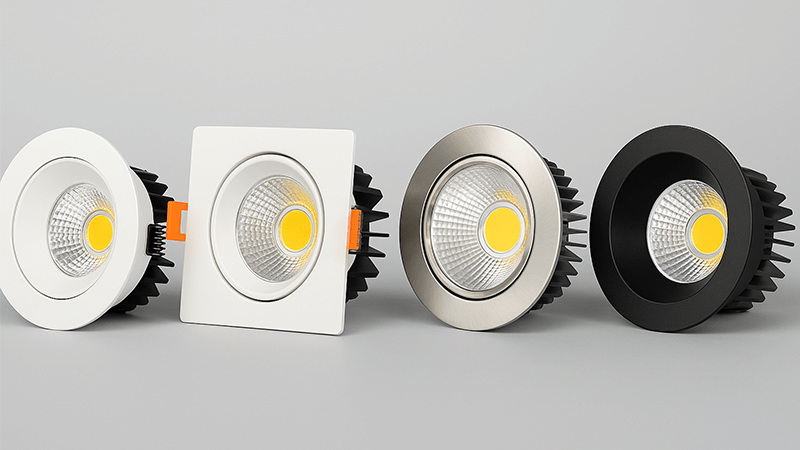
When advising on large projects, I always highlight the long-term benefits of the technology we choose. For project contractors and developers, COB technology is not just about a better light; it's about building a better, more efficient, and more reliable asset. It simplifies things and saves money down the road.
Higher Light Output in a Smaller Package
One of the biggest wins for COB technology is its high lumen density. This means we can get a huge amount of light out of a very small source. For architects and designers, this is fantastic. It allows for the design of smaller, more discreet light fixtures that can blend seamlessly into the architecture without sacrificing performance. Instead of large, bulky fixtures, you can use sleek, minimalist downlights that deliver powerful, high-quality illumination. This cleans up ceiling lines and contributes to a more modern and sophisticated aesthetic in any building project.
Superior Longevity and Reliability
As a manufacturer, I know that longevity is directly linked to quality. The advanced thermal management of COB LEDs is their greatest strength. By efficiently drawing heat away from the LED chips, COB lights run cooler, which dramatically slows down lumen depreciation and extends their operational lifespan. Quality is crucial here. When sourcing COBs, I always tell clients like Shaz to check the lumen maintenance data, often from an LM-80 test report. If a supplier can't guarantee at least 95% light output after 2,000 hours, it's a major red flag. It means the product will dim quickly, and you'll be replacing it far sooner than you should. This commitment to quality and longevity is a core part of our mission at iPHD.
Energy and Cost Savings
For any building owner or manager, operational cost is a top priority. COB LEDs are extremely energy-efficient, boasting high efficacy numbers (lumens per watt). This means they produce more light for every watt of electricity consumed, leading directly to lower electricity bills. When you apply this across an entire parking garage with hundreds of lights running 24/7, the savings are substantial. This efficiency, combined with their long lifespan, creates a powerful financial argument. You save money on energy every day, and you save money on maintenance and replacement costs over the years.
| Advantage | Benefit for a Building Project |
|---|---|
| Compact Size | Allows for smaller, more aesthetic fixture designs. |
| High Efficacy | Drastically reduces electricity costs and carbon footprint. |
| Long Lifespan | Minimizes maintenance and replacement costs. |
| Uniform Light | Creates a higher quality visual environment for users. |
Conclusion
In summary, COB LED downlights12 are a superior choice for parking garages. They provide bright, safe, and energy-efficient lighting that significantly lowers long-term costs and enhances user experience.
Discover how proper lighting can enhance the overall user experience. ↩
Learn how effective lighting can enhance the value of a property. ↩
Understand the importance of thermal management for the longevity of LED lights. ↩
Understand the factors that ensure COB LED lights last longer and perform better. ↩
Learn why lumen maintenance is crucial for the performance of lighting fixtures. ↩
Explore how light density impacts the effectiveness of lighting solutions. ↩
Explore how COB lighting can enhance the aesthetics of modern architectural designs. ↩
Find out how high-intensity spotlighting is applied in various settings. ↩
Learn about the benefits and uses of diffuse lighting in different environments. ↩
Discover the advantages of using COB technology in construction. ↩
Explore the features that contribute to the energy efficiency of COB lights. ↩
Explore the advantages of COB LED downlights for efficient and safe lighting solutions. ↩

